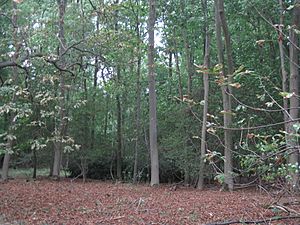Madingley Wood facts for kids
| Site of Special Scientific Interest | |
 |
|
| Area of Search | Cambridgeshire |
|---|---|
| Interest | Biological |
| Area | 15.4 hectares |
| Notification | 1986 |
| Location map | Magic Map |
Madingley Wood is a special natural area covering about 15.4 hectares. That's roughly the size of 38 football fields! It's located near Madingley, right on the western edge of Cambridge, England. This wood is officially known as a Site of Special Scientific Interest (SSSI). This means it's a protected place because it has important plants, animals, or geological features. Madingley Wood is recognized for its valuable plant life.
Contents
What Makes Madingley Wood Special?
Madingley Wood is divided into two main parts, each with different types of trees.
Trees and Plants
The western part of the wood is very old. It's filled with pedunculate oak trees. These are a type of oak tree where the acorns grow on stalks. You can also find other trees like ash and field maple here. Below the taller trees, there's a layer of smaller shrubs. These include hazel and hawthorn bushes.
The eastern part of the wood is newer. It mainly has elm and ash trees. Across the entire wood, you can discover a wide variety of mosses. These tiny plants add to the rich plant life of the area.
Research and Education
For many years, Cambridge University has used Madingley Wood. It's a great outdoor classroom and laboratory for students and scientists. They use the wood for important research and teaching. This helps us learn more about how woodlands grow and how different species interact.
Visiting Madingley Wood
Madingley Wood is mostly private land. This means that most of the wood is not open to the public. However, there is a public footpath. This path crosses the eastern end of the wood. It allows people to enjoy a small part of this special natural area.
Nearby Woodlands
Madingley Wood is next to another interesting woodland. This is Cambridge University's "800 Wood." This nearby site covers 10 hectares. It was planted with 15,000 trees in 2009. This planting celebrated the university's 800th anniversary. Both woods contribute to the green spaces around Cambridge.

